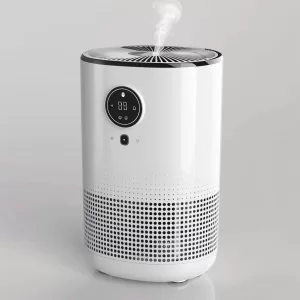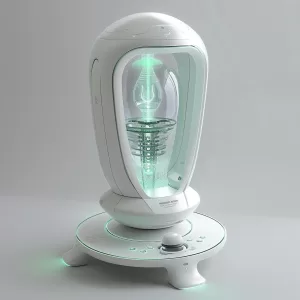
Air Purifier VS Ionizer: Clearing the Air
February 19 2024 
Inquiry
Global electronic component supplier AMPHEO PTY LTD: Rich inventory for one-stop shopping. Inquire easily, and receive fast, customized solutions and quotes.
QUICK RFQ
ADD TO RFQ LIST
In this blog, we will delve into Two popular options to clean the air — Air Purifiers and Ionizers. And we will help you make an informed decision on which one is right for you.
What is an Air Purifier?

- Air purifiers are appliances that draw in air, trap pollutants in filters, and release cleaner air back into the room.
- They have different types, each targeting specific pollutants:
- HEPA (High-Efficiency Particulate Air): Removes 99.97% of airborne particles 0.3 microns or larger (dust, pollen, mold spores).
- Carbon: Captures gasses and smells, such as volatile organic compounds (VOCs) and smoke from cigarettes.
- Electrostatic: Particles are drawn to and retained by electrically charged plates.
Why Air Purifier is Important?
- Health benefits: Breathing becomes easier, allergy symptoms lessen, and general well-being increases with cleaner air.
- Situation-specific: Especially helpful for people who live in polluted areas, have pets, suffer from allergies or asthma, or have smokers in the home.
- Extra features: Some air purifiers come equipped with remote controls, variable fan speeds, and sensors for measuring air quality.
What is an Ionizer?

Who Invented Ionizer?
Early Developments:- 1752: Benjamin Franklin conducted experiments with electricity and observed the phenomenon of ionization.
- 1900s: Scientists began exploring the potential of ions for therapeutic purposes and air purification.
- 1918: Alexander Chizhevsky developed the first air ionizer for animal health in agriculture.
- It is uncertain who invented the contemporary ionizer, which is widely used in homes.
- Over the 20th century, several scientists and engineers most likely contributed to the technology's advancement and improvement.
Why Use Ionizer?
- Reduced airborne pollutants: Ionizers have the power to draw in and gather airborne particles, such as smoke, pollen, and dust, making them heavier and more likely to settle on surfaces that can be cleaned. Those who have dust allergies or sensitivities may find this useful.
- Odor reduction: By reacting with odor molecules and neutralizing their charge, ionizers can assist in eliminating certain airborne scents.
- Fresher air: Although this is entirely subjective and unsupported by concrete scientific data, some people believe that ionizers create a sensation of fresher air.
- Relatively inexpensive: Ionizers are generally less expensive to buy than premium HEPA filters.
Video related to Air Purifier VS Ionizer
How Air Purifier Works?
Step 1: Air Intake- Through the use of a fan or another mechanism, the air purifier takes in contaminated air from the surrounding area.
- Pre-filters may be incorporated into the intake design to collect bigger particles, such as dust and debris before they get to the primary filtration stage.
- The core of an air purifier's functionality lies in its filtration system. Different types of filters are used depending on the specific air purifier and its intended purpose.
- HEPA filters: Capturing particles as small as 0.3 microns, these high-efficiency particulate air filters are particularly effective at removing allergies, smoke, dust, pollen, and even some bacteria and viruses.
- Carbon filters: These filters take up volatile organic compounds (VOCs), cigarette smoke, and other gaseous contaminants.
- Additional filters: Certain air purifiers come with extra filters for particular uses, like electrostatic precipitators to attract and collect charged particles, UV light filters to destroy bacteria, and pre-filters for bigger particles.
- As air passes through the filters, the pollutants get trapped, leaving cleaner air behind.
- A fan then forces the cleaned air back into the space. This establishes a pattern of circulation that aids in dispersing the fresh air throughout the area.
- In addition, some air purifiers contain features like ionizers (discussed in earlier comments) or air quality sensors, which change the filtration level or fan speed in response to contaminants that are identified.
How Ionizer Works?
Step 1: Ionization- High-voltage generation: To produce an electric field, the ionizer requires a high-voltage electrode. Air molecules are accelerated by this field, which causes their electrons to break free.
- Positive or negative ions: Either positive or negative ions can be produced by the ionizer, depending on its design. Negative ions are most frequently produced because of their possible health advantages.
- Charged particles: The recently formed ions have an electrical charge due to the addition or removal of an electron.
- Attracting opposites: The airborne pollutants that are attracted to these charged ions are frequently neutral or have the opposite charge.
- Clumping together: As the ions and pollutants collide, they stick together, forming larger clusters.
- Heavier particles: The clumped particles are less likely to remain in the air due to their increased size and weight.
- Settling and collection: The heavier clusters eventually fall to the ground or rest on surfaces from which they can be readily cleaned.
What's the Difference between Air Purifier and Humidifier?
Function:- Air purifiers: Eliminate impurities and airborne pollutants from the atmosphere, including dust, pollen, smoke, allergies, bacteria, and viruses. Like a "cleaner" for the air, it works.
- Humidifier: This device raises the humidity level in the air by adding moisture. It functions as an airborne "moisturizer".
- Air Purifier: These devices physically trap pollutants using filters such as HEPA filters, or they use electrostatic precipitators to draw in and collect pollutants.
- Humidifiers: Steam diffusers, evaporative coolers, and ultrasonic coolers are a few of the techniques available. In all three methods—evaporative, which requires passing a fan over soaked wicks; steam diffusers, which entail boiling water and distributing the steam—water vapor is introduced into the air.
- Air Purifiers: They reduce exposure to dangerous pollutants, enhance air quality, ease the symptoms of allergies and asthma, and may even be beneficial for general respiratory health.
- Humidifier: By adding moisture to dry air, a humidifier can reduce congestion, enhance sleep, relieve coughs and dry skin, and possibly prevent wooden furniture from cracking.
- Air Purifier: Air purifiers can be noisy, need frequent filter changes, and some may even create ozone (check before purchasing).
- Humidifier: If not maintained properly, excessive use might result in mold growth, exacerbating allergies. Certain models also need to be refilled regularly.
How Long Do Air Purifiers Last?
- Lifespan varies: Brand, model, and usage dependent.
- Typically 5-10 years: With proper maintenance (filter replacements).
How Long Does a Clarifion Air Ionizer Last?
- 3-5 years: With proper cleaning and maintenance.
- Replacement needles: Depending on the model.
Conclusion
In conclusion, while they both contribute to bettering the quality of the air, air purifiers and ionizers operate very differently. Ionizers combine pollutants like smoke, dust, and pollen to create a heavier and more easily falling mixture, whereas air purifiers remove these pollutants actively. Your unique needs and concerns will ultimately determine which option is best for you. Consider using an air purifier if you value respiratory health and maximum particle removal. But an ionizer might be a useful addition if your major worry is smells and you have allergies to airborne particles. What is an Air PurifierWhy Air Purifier is ImportantWhat is an IonizerWho Invented IonizerWhy Use IonizerVideo related to Air Purifier VS IonizerHow Air Purifier WorksHow Ionizer WorksWhat's the Difference between Air Purifier and HumidifierHow Long Do Air Purifiers LastHow Long Does a Clarifion Air Ionizer LastConclusion
Related Articles
- ·Stratix 10 VS Stratix V: Which FPGA is Right for Your Next Project?
- ·Intel Xeon Platinum 8454H vs AMD EPYC: Which Reigns Supreme?
- ·A Deep Dive into the AMD EPYC 4564P Processor
- ·MSP430F5438A vs MSP430F5529: A Detailed Analysis of Their Capabilities
- ·Comparing MSP430F6659 and MSP430F5419A: Which One is Right for Your Project?
- ·Exploring the Features of MSP430F5529 and MSP430F5638 Microcontrollers
- ·Demystifying 20 Microcontroller Projects for Beginners
- ·Unveiling the Ultimate Guide to Microcontroller Programming
- ·4680 Battery: Unveiling the Power Potential of the Next-Gen Cell
- ·Exploring the Case Studies on Arduino Applications
Populer Posts
